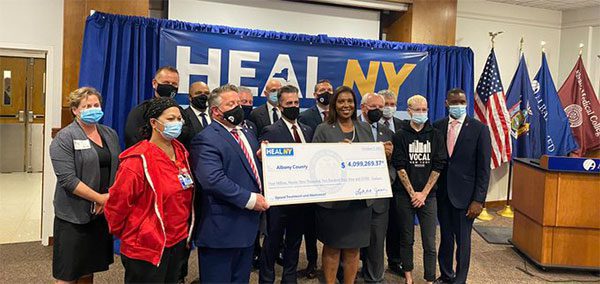Subscribe!

It was with dismay that I read recent news reports about New York Attorney General Tish James embarking on a “HealNY” tour around the state to announce the distribution of $1.5 billion to fight the opioid epidemic.
The press announcements from the Attorney General’s office appear to give her full and sole credit for the amounts and distribution of this fund. For example, an October 4 press release says: New York Attorney General Letitia James will begin her ‘HealNY’ statewide tour that will deliver up to $1.5 billion to New York communities most impacted by the opioid crisis….Today’s announcements are the first in Attorney General James’ statewide tour taking place throughout October, where she will highlight her efforts to combat the opioid crisis in New York and across the nation.”
A follow-up led with the announcement that “Elected Officials and Advocates Across New York City Praise AG James’ Continued Efforts to Deliver Funds for Opioid Abatement to Five Boroughs.”
This reminded me of a similar situation six years ago when Manhattan District Attorney Cy Vance announced a plan to make grants totaling $800 million to a variety of criminal justice programs. In both instances, the funds to be allocated came from settlements of civil litigation — the DA’s from banks and the AG’s from drug companies.
Oh no, I thought, here we go again!
When the DA’s criminal justice fund was announced, I said that notwithstanding his good intentions and reliance on a respected and capable entity to administer the program, it is the legislative budgeting process that should make spending decisions about money paid to city or state government, not a law enforcement officer:
“…the law giving Mr. Vance sole control over the funds should be reconsidered. Ideally…the money should have been treated as revenue to the city, and its expenditure determined through the budget process.”
“No one official should be making decisions about how substantial sums of revenue are distributed…”
I had also made this point when a dispute broke out between then-Attorney General Eric Schneiderman and then-Governor Andrew Cuomo about who had the authority it distribute more than $600 million from a settlement with JP Morgan:
“Funds paid in settlement of litigation with the state, unless intended to compensate for specific losses, should be used as determined through the normal budget and appropriation process. The attorney general should not be able to unilaterally allocate public funds without the executive and legislative review that the budget process is intended to provide.”
So the campaign-style roadshow by Attorney General James indicated that once again litigation-generated revenue was being inappropriately distributed by a prosecutor outside the budget process. But fortunately, that turns out not to be the case.
The Attorney General collaborated with members of the State Senate and Assembly to pass legislation this year creating an Opioid Settlement Fund to serve as a lockbox for all receipts from settlements related to the opioid epidemic, reserving all of the funding for substance use disorder prevention, treatment, and recovery. The Fund will be overseen by a 19-person board including commissioners of relevant state agencies and two appointees of the AG as well as appointees of the Governor, both houses of the Legislature, and nominees of counties and other localities. The law specifies the purposes for which the funds from the relevant litigations may be used and a formula for distributing the funds throughout the state.
How reassuring to see that the AG understood that the monies she would obtain from the opioid litigation should be controlled by appropriation of the Legislature, with her office’s input but not ultimate authority. The full Settlement Fund Board has not been appointed yet and therefore the specific distribution of funds has not been determined and likely will not be completed by the November 1 date in the statute.
While it would be far better if all litigation proceeds were deposited in the general fund to be used as needed to fund the government, this structure is an improvement over prior law and practice, and that is more important than the impression left by the AG’s tour that one elected official is disbursing a big chunk of money on her own.
This post was originally published on October 15th by Gotham Gazette.